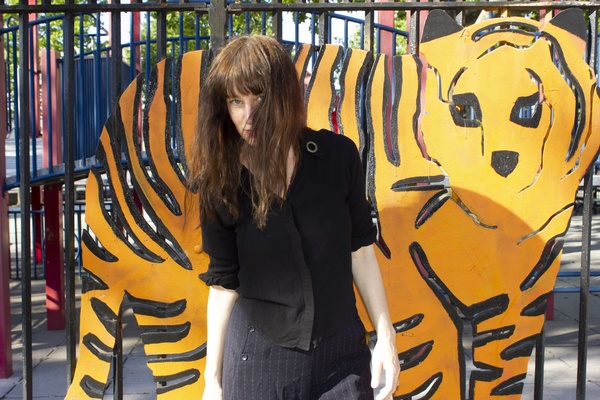Marina Rosenfeld is an artist and composer based in Brooklyn, NY. Her works explore acoustic architectures and experimental forms of participation and sociality in sound, sculpture, and performance. Her work is currently featured in the solo exhibition ?We?ll start a fire? at the Kunsthaus Baselland in Switzerland, with a performance program planned featuring longtime collaborator Okkyung Lee (cello). Other recent projects include the sound-art survey ?Seeing Sound? at the Kadist Foundation, San Francisco, and a solo exhibition at Miguel Abreu Gallery in New York.

|
|
|
|
|
|
|
|
|
|
|
|
CD/BOOK
|
|
RM 4173CD
|
For over two decades, New York-based artist and composer Marina Rosenfeld has pioneered a specific language for turntable music, based on an ever-expanding collection of dub plates she creates. The dubplate is a one-off, hand-cut record. Each dubplate can be made to contain any array of sounds decided on by its creator. For Rosenfeld, her discovery of the dubplate in the late 1990s was a pivotal moment, when she recognized the material instability of the medium as critical tool for performance and composition. On Index, the investigation of this materiality is paramount. The physical intimacy that colors the relation between the hand and the plate is revealed through a very particular reading of the turntable, one which sits in parallel to the more recognized ways in which that technology has been deployed as a performative tool. This edition features a series of live recordings and related materials that trace the development of Rosenfeld's tactile approach and her shifting collection of sound materials. The recordings are published alongside a book featuring extensive archival documentation, photography, and a longform conversation between Marina Rosenfeld and Lawrence English.
Marina Rosenfeld on the dub plates: "I don't care that much about the alchemy that some artists generate combining LPs, communicating with the ghosts of the past, that kind of thing. I love it when other people do it. In my own case, I'm really interested in the materiality of the plate, the tactile and hyper sensitive way sound is extracted from it, the signal to noise ratio and its condition of radical flux that you get with dub plates. What I'm doing there is adjacent to music-making, but I often think it might not be strictly speaking, about getting to the best sound, if that's what musicians are understood to be doing, by and large. My approach has something of carrying out exercises to it, to what end I'm not entirely sure, but on a personal level, I would say, some strange synthesis of formalism and kind of physical intimacy."
|
|
|
Artist |
Title |
Format |
Label |
Catalog # |
|
|
LP
|
|
RM 4121LP
|
Teenage Lontano and roygbiv&b, from 2008 and 2011 respectively, comprise two key works by composer and artist Marina Rosenfeld. Both works are choral compositions imagined for and enacted by teenagers. Premiered in New York's immense Park Avenue Armory, Teenage Lontano is Rosenfeld's groundbreaking "cover version" of Hungarian composer György Ligeti's 1960s classic for orchestra. Teenage Lontano is reimagined as an immersive sound environment bisected by a column of teenagers in headphones. Beneath a loudspeaker rotating at the phonographic speed of 33 1/3 rpm, the teens' collective voices produce a hauntingly vulnerable account of Ligeti's dissonant polychords. Teenage Lontano has been performed on three continents, including a French premiere in 2020 as part of Musica Strasbourg. In roygbiv&b, asynchronous, sometimes raucous incantations of song fragments swell and dissipate, loosely organized around a purposeful mis-hearing of the acronym ROYGBIV: in Rosenfeld's version, "r" evokes "are" (as in, "Are you that somebody..."); o is "oh" ("Oh, oh, oh?"); y becomes "why" ("Why should my heart...); g is "je (sus)", and so on. The extra "b" in the work's title pays homage to the "blue(s)" of r&b. Rosenfeld's punning, spectral composition had its debut performance at the Museum of Modern Art in 2011. The recording featured on this edition took place at the South London Gallery in 2014 realized by local south Londoners, the recording highlighting their style and genre affiliations. Both works have remained unpublished until now.
|
|
|
Artist |
Title |
Format |
Label |
Catalog # |
|
|
LP
|
|
RM 452LP
|
Restocked, last copies. On P.A./Hard Love, New York-based composer and conceptual sound artist Marina Rosenfeld generates an esoteric universe of radical sonic collisions. Developed initially in 2009, the album draws its roots following a series of idiosyncratic quasi-sculptural sound-system installations Rosenfeld installed in various disused and monumental sites including New York's Park Avenue Armory and Liverpool's Renshaw Hall car park. The music she composed for these installations was heterogeneous, repositioning resident noise from the sites (re-projected back into the sites via horns), her own voice and generous yet subtle electroacoustic elements. The results were more "tuned" atmosphere than active performance and sought to explore the potent combination of voice, amplification and space; playing with reflection and distortion, intelligibility, fantasies of publicness and broadcast. In 2012 Rosenfeld reached out to Annette Henry, aka Warrior Queen, and invited her to contribute original vocals to the project. The vocal contributions acted as a catalyst for the works; propelling the pre-existing compositions into new and unexpected directions. In combination with virtuoso cellist Okkyung Lee, the material was transplanted from live settings to the studio and transformed by a process of radical iteration. The resulting music asks questions of form, expectation and contemporary sound practices. P.A./Hard Love reveals the contingent nature of collaboration; something beautiful and complicated, and ultimately it's these relationships that form a kind of halfway point between conceptual art and contemporary music. It's in these in-between spaces that delicate, shimmering and ephemeral sounds can exist harmoniously with dissonant, abrasive, dark and complex audio states that are both explicit and ambiguous, anthemic and elusive. Limited vinyl edition of 500 copies housed in a gorgeous matte cello-glazed sleeve.
|
|
|
|